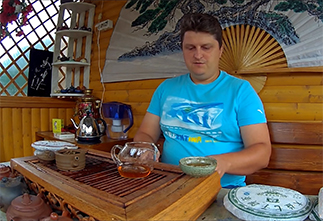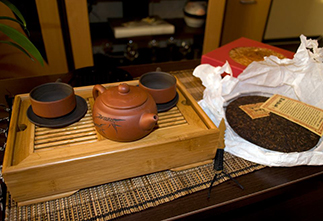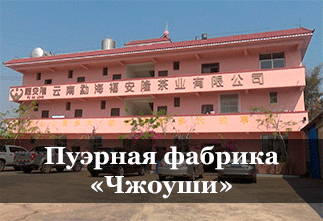Shu Puer "Blossom": Anniversary cake from the heart of the tea world
Shu Puer "Flowering" (Chinese: 绽放, pinyin: zhànfàng) is not just a tea, but a real work of art, created at the Zhou Shi factory in honor of its tenth anniversary. This anniversary cake, pressed in 2023 from 2013 raw materials, is the embodiment of the rich traditions and highest skill of Chinese tea masters.
The name of the puerh "Flowering" (绽放, zhànfàng) carries deep symbolism and reflects several aspects of this unique tea:
- Revealing aromas and flavors: Just as a flower opens up and fills the world with its aroma, so this puer gradually reveals its multifaceted flavor and aroma nuances when brewed. With each infusion, the tea seems to "bloom", giving new shades of taste and aroma.
- Anniversary Release: The name "Blossom" can also symbolize a new stage in the life of Zhou Shi Factory, which released this tea to celebrate its 10th anniversary. It is like a blossoming flower that marks the beginning of a new milestone.
- Jingmai Origin: The Jingmai region is famous for its ancient tea trees and unique microclimate, which gives teas from this region a special depth and complexity of flavors. The name "Blossom" may be a reference to the lush vegetation of this region and the way the tea trees "bloom" in it.
- Fermentation process: Shu Puerh undergoes a complex fermentation process, during which profound biochemical changes occur within it. The name "Blooming" can metaphorically describe this process, comparing it to the blossoming of a flower.
Thus, the name "Blossom" is multifaceted and reflects both the organoleptic properties of tea and its symbolic meaning associated with the cycles of nature, development and renewal.
Additional nuances:
- The character绽(zhàn): Means "to blossom", "to open up". It perfectly conveys the idea of the gradual unfolding of the aromas and flavors of tea as it brews.
- Character放(fàng): Means "to release", "to liberate". It can symbolize the release of aromas and flavors of tea when brewing, as well as the feeling of freedom and lightness that comes with drinking tea.
The name "Blossom" is a poetic and profound reflection of the essence of this unique tea. It invites us to enjoy a journey through the multifaceted world of aromas and flavors that begins with each new brew.
Origin and characteristics of tea
The raw material for "Blossom" is the large-leaf variety "Da Ye Zhong", grown in the famous tea region of Jingmai, located in Lancang-Lahu Autonomous County of Pu'er City. The tea bushes, growing among other trees, absorb the aromas of orchids and mountain forests, giving the tea a unique bouquet.
The production of shu puer "Blossom" is carried out using the traditional technology "Shai Qing Mao Cha", which includes fixing, crushing and drying the tea leaf. This method allows you to preserve all the useful substances and bright aroma in the tea.
Aroma and taste
The dry leaf of "Blossom" has a piquant sweetness with a slight saltiness, characteristic of high-quality shu pu-erhs. When heated, the tea reveals amazing aromas of baklava, puff pastry and maple syrup. After washing, a bright camphor aroma appears, harmoniously combined with notes of noble wood and sweet marshmallow.
The taste of the "Tsvetenie" infusion is deep and multifaceted. You can distinguish shades of amaretto, chocolate ganache and nutty M&M's in it. With each subsequent infusion, the tea reveals new facets, acquiring more pronounced woody notes and a long chocolate aftertaste.
|
Name in Chinese
|
绽放 |
|
Pinyin
|
Zhangfang |
|
Country
|
China |
|
District
|
Pu'er City District |
|
Provinces
|
Yunnan (云南) |
|
Habitat
|
Цзинмай (景迈, jǐngmài) |
|
Manufacturer
|
Чжоуши (周氏) |
|
Raw material production date
|
2013 |
|
Year of pressing
|
2023 |
|
Pressing form
|
Bing Cha (Cake Tea) |
- Комментарии
- Вконтакте
Pu-erh is one of the most unique types of tea, which only gets better with age. Many people, when they first encounter this tea, wondered: why is pu-erh more often found in pressed form (cakes, bricks, tochas), and not in loose form? The reasons for this are related to both history and the practical aspects of storing and fermenting tea. Despite modern technologies that allow the production of loose pu-erh, the shape of pressed cakes remains unchanged. And pu-erh is more often found on sale in pressed form, for example, in the form of cakes or bricks, and loose pu-erh is less common. We will talk about the reasons for pressing pu-erh into cakes in this article.
Puer is a unique Chinese tea that is distinguished by its depth of taste, complexity of aromas and versatility of aftertaste. Its taste characteristics are formed under the influence of many factors, from growing conditions to the brewing method. Let's look at the main ones.
Jingmai Mountain is the birthplace of tea and one of the six major tea mountains in China. This mountain is home to the oldest and largest cultivated ancient tea garden in the world, which has witnessed the development of Chinese tea culture. Jingmai Mountain is famous for its long history of producing high-quality Pu'er tea.
The question often arises: how to brew puerh correctly? Sometimes the phrase "to get high" is added to it. Moreover, everyone has their own understanding of this phrase. Some mean vigor, and some - intoxication. So how to brew puerh tea correctly? Let's consider several options.
Traveling through the tea mountains, we found ourselves in another land of blue roofs - the village of Zhongcai, which is located in the Menghai district of Yunnan province. According to tradition, we were shown another local tea tree, which, according to the Chinese, is at least a million years old :) The village is very authentic, not designed for tourists, there are many wild pu-erhs there and, of course, we were warmly received. They treated us to local cuisine and tea. We also asked the residents about the prices of tea and how they have changed in recent years.
Well, finally we got to the Zhoushi puer factory, which is located in Menghai, Yunnan Province. We first purchased their cakes remotely several years ago and they were to the taste of Russian tea people. Now it's time to personally meet the owners and expand the range of this brand on the shelves of ChL. In this video, you will see the production process of the already familiar cakes, rare shots of the nuances of packaging and the atmosphere of such places.
The tea ceremony occupies a special place in the centuries-old Eastern tradition. And although the essence of this phenomenon remains constant, the nature and external manifestations of the tea ceremony in different nations have their own national characteristics. In each Chinese province, the tea ceremony and the tea used in it are varied: for example, residents of the southern provinces prefer green tea, and residents of the northern provinces - red tea, in Fujian province they more often use Oolong tea, and in Yunnan province Puer tea is widely known.


























































































